New Light Twin From Italy
Tecnam introduces a twin-Rotax-powered four-seater in the tradition of the Partenavia P68C
 Naples, Italy, April 18, 1986: Today, I'm first in line for takeoff from Naples toward our initial destination of Nice, France. It has taken all morning to assure that the paperwork is up to Italian standards, but we're finally ready, or so I hope. For this trip, I'm leader dog of a small band of not-so-intrepid aviators who are, allegedly, experienced in ferrying little airplanes across big oceans.
Naples, Italy, April 18, 1986: Today, I'm first in line for takeoff from Naples toward our initial destination of Nice, France. It has taken all morning to assure that the paperwork is up to Italian standards, but we're finally ready, or so I hope. For this trip, I'm leader dog of a small band of not-so-intrepid aviators who are, allegedly, experienced in ferrying little airplanes across big oceans.
It's our fourth day in Naples, waiting for a customs strike to be resolved.
(I finally resolved it with $1,200---2.4 million lira at that time---paid to a friendly Italian customs agent at his home to compensate him for "overtime fees.") There are three more new Partenavia P68s in line behind me, the last of 15 we've contracted to deliver from Italy to points west, primarily Florida and California.
Naturally, since I live in the Golden State, this and my other three Partenavia deliveries have all been to the company's U.S. distributor, Mira Slovak, on the West Coast. Slovak, a Continental Airlines 747 captain in his day job, is based at Santa Paula Airport, 30 miles from Santa Barbara. That means the total trip is about 6,000 nm from Italy to Southern California.
 The P68 is a reasonably talented six-place twin, possessed of surprising STOL characteristics, a comfortable cabin and easy handling, but it has fixed gear and a pair of 200 hp Lycoming engines, worth perhaps 150 knots' cruise on a good day. Headed west, into the wind, even in summer, there are few good days.
The P68 is a reasonably talented six-place twin, possessed of surprising STOL characteristics, a comfortable cabin and easy handling, but it has fixed gear and a pair of 200 hp Lycoming engines, worth perhaps 150 knots' cruise on a good day. Headed west, into the wind, even in summer, there are few good days.
This is my fourth and last delivery flight in a Partenavia, and I finally receive clearance to go. I climb out over the beach, leaving Naples, and watch the Italian coast fade into the haze. I set course across the Mediterranean for Corsica and listen on the tower frequency to make certain my three playmates are off and running.
It's only 350 nm to Nice, and if we're lucky, we'll arrive early enough to make a run to Monte Carlo. Nice is the closest airport to one of the world's smallest sovereign countries and, of course, the location of Monte Carlo's famous casinos. Tomorrow, we're off to start the trek to Iceland, Greenland and North America.
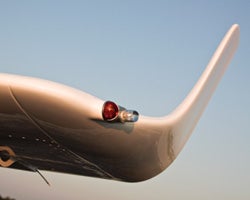 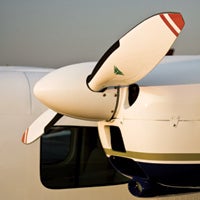 Most of the P2006T is constructed of pure aluminum, with the exception of the molded fiberglass winglets, which reduce stall to 47 knots. Tecnam's first twin-engine aircraft can seat up to four people and is powered by dual 100 hp Rotax 912S engines. |
Fond du Lac, Wis., August 2, 2009: This time, I'm second in line, in a manner of speaking. Thirty feet ahead and slightly to my right, a Skyhawk rotates off the asphalt of runway 36 and starts uphill at 65 knots, the rising sun directly behind it. I'm flying a twin, for Pete's sake, so I know I won't be able to hold formation with it in the climb.
Or will I? Photographer Jim Lawrence is leaning out the left window, looking eagerly back through the lens of his Canon, so I try a tentative pull on the yoke just to measure the airplane's response, already positive it's too slow to fly. To my amazement, the high-wing twin is smarter than I am. It comes off cleanly and begins to climb away, holding position nicely on the little Cessna ahead.
Fortunately, the lead pilot in this photo formation takeoff is reasonably savvy and keeps his climb rate low to give me a chance to gain speed. Still, I'm impressed that a twin could stay back with a light single on takeoff.
No, this isn't an Aero Commander or a Mitsubishi MU-2. And, no, it's not a Partenavia either, though it's probably about as close as you can come. Instead, it's the newest piston twin in the world, the Tecnam P2006T (www.tecnamaircraft.com), a design based heavily on those P68s I flew a quarter century ago.
For that reason, it was with more than the usual curiosity that I climbed aboard the new Italian twin at Fond du Lac after the Oshkosh show to evaluate the new airplane. Tecnam's P2006T has a strong resemblance to the Partenavia P68, and tha3t's more than coincidental: Both airplanes were designed by the same man, Professor Luigi Pascale.
In fact, the P2006T appears to be a near-perfect, scaled-down, retractable replica of the P68 (later renamed the Vulcanair). Tecnam is hardly new to the aircraft manufacturing business. Since 1992, the Italian company has produced some 2,500 single-engine airplanes, many of them LSA long before there was any such abbreviation.
The whole concept of offering a new twin seems almost heretical in this time of reducing production rates and shrinking budgets. The last new twin was the Diamond Twin Star (now referred to only as the DA42 because of a lawsuit by Aérospatiale). The P2006T is Tecnam's first twin-engine airplane. At first, Tecnam considered simply enlarging one of its existing two-seat singles to create a me-too, four-place airplane, but the company decided instead to offer the world's most economical certified twin, targeting the multi-engine training market.
Professor Pascale designed the P2006T to carry a maximum of four people and fly behind a pair of Rotax 912S engines, rated for 100 hp each. That wasn't his first choice to power the new twin. Concerned about the shrinking supply and availability of avgas, Pascale had hoped to mount a pair of German Thielert diesels on the wings (Ã la the aforementioned Diamond DA42), but Thielert's financial problems and eventual bankruptcy made that an unlikely possibility. Pascale also considered the French SMA engines and an all-new Italian diesel developed by the Fiat Research Center, but none of those were exactly right for the new Tecnam either.
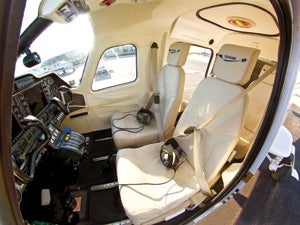 The P2006T is targeted at the multi-engine training market, and with a relatively economical price tag, it has few head-to-head competitors. |
In the end, Pascale chose the Rotax mills for a variety of reasons. For one thing, they're remarkably light powerplants. The diminutive Rotax 912S weighs in at only 141 pounds, a total of 282 pounds for a pair. In contrast, the equivalent single Lycoming IO-360-A1A tips the scales at 321 pounds, so the Tecnam with dual Rotax power is actually 40 pounds lighter than having a single Lycoming out front.
Similarly, the frontal area of the Rotax engine is only about 1.5 square feet, three square feet total for two, compared to 6.9 square feet for the Lycoming. In other words, the drag profile of the twin Rotax engines was actually more efficient than with a single Lycoming IO-360. Another factor in favor of the Rotax was that the 912 is approved for autogas.
The Rotax uses a 2.43 reduction gearing to downgrade the engine's 5,800 rpm to 2,400 prop rpm. Technically, the 912S engines are rated for 98 hp apiece on takeoff and 92 hp maximum except takeoff (METO) power. The 912S also is liquid-cooled, so it's less susceptible to the ills of shock cooling.
A mere total 200 hp might seem a little weak for a twin, but the Tecnam's gross weight is only 2,600 pounds. At 13 pounds/hp, power loading is less than the Piper Arrow's; it uses the same total horsepower to fly with 2,700 pounds, and the old Mooney 201 employed similar power to levitate 2,740 pounds.
The surprise comes in that the P2006T offers a low 47-knot stall speed, this from a mere 159 square feet of wing---again, significantly smaller than the wings on either the Arrow or 201.
Pascale designed the P2006T to be constructed almost entirely of metal. The sculpted winglets atop each wingtip are molded fiberglass, but the rest of the airplane is mostly pure aluminum. Wings feature single-spar design with long-span ailerons and, as mentioned above, the big flaps reduce stall to a leisurely 47 knots.
There are two doors for cabin access, a conventional left side crew door for copilot and pilot, plus an aft right side door for passengers. Entry to the front office is a simple matter of stepping in and settling into the seat. No climbing, no insinuating your body around a strut or floor-mounted control column.
The cockpit layout is fairly conventional, and of course, the demonstrator I flew had all the options, including the Garmin G1000 glass panel. There's an analog version of the P2006T that uses a Garmin GNS 530 and a stack of secondary NAV/COM, transponder and autopilot.
I flew the airplane with two passengers, student pilot Peggy Herrera in the right rear and Tommy Grimes, CEO of Heart of Virginia Aviation, in the copilot seat. Grimes was planning to refuel and depart for Richmond, Va., when we finished our air-to-air photos and flight evaluation, so he was eager that I not break anything. Heart of Virginia Aviation (www.flyhova.com) is one of five Tecnam dealers in the United States, and the first to receive a P2006T.
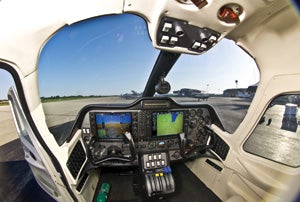 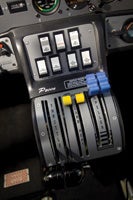 Among the options for the P2006T is Garmin's G1000 glass panel. |
Making your first takeoff in a new model in tight formation with a photo ship is a challenge for any airplane, but I was surprised that the Tecnam twin seemed imminently manageable. As we climbed out together toward Lake Winnebago, the P2006T held position easily, making my job ridiculously simple.
Unlike the Partenavia/ Vulcanair, which flies above fixed gear, the Tecnam utilizes a standard electro-hydraulic retraction system. The trailing-link gear is mounted in pylons that extend horizontally outboard from the lower fuselage abeam the rear seats. The wheels fold into partially open wells in the bottom fuselage. Gear retraction is quick, about six seconds up and four seconds down. (If demand is strong enough, Tecnam hopes to offer a less expensive fixed-gear version sometime in the future.)
Cleaned up and accelerated to 90 knots, the P2006T scores a reasonable 1,000 fpm climb at gross, 1,200 fpm at lighter weight. Single-engine climb is listed at 230 fpm, but this was the only Tecnam twin in the States, and we weren't allowed to do any unimotor flying. Service ceiling is 15,000 feet, so flight at altitudes as high as 11,500 shouldn't require unreasonable climb times.
On the way uphill, you can't help but notice this is a responsive little twin. (Of course---it's Italian.) The Frise ailerons are quick and induce a fairly frisky roll rate, and the all-flying stabilator provides good pitch control in all attitudes from stall to cruise.
Tecnam lists the P2006T's single-engine service ceiling at 7,000 feet, and coincidentally, that's the optimum cruise altitude for the airplane with both engines running true. Cruise with everything against the stops works out to 140 knots or a bit more. Climb to 9,000 feet, where 65% is all there is, and you'll still see 135 knots on perhaps 1.5 gph less fuel burn.
Perhaps because specific fuel consumption is fairly immutable, a pair of 100 hp Rotax mills burns about the same as a single 200 hp Lycoming at 74%, around 10 gph. Most piston aircraft engines consume fuel at 0.40 to 0.42 lbs./hp/hr. That's 10 to 10.5 gph total in either mode. At the aforementioned 65% setting, burn drops to 4.4 gph/engine, 8.8 gph total.
With a max fuel capacity just under 53 gallons, endurance at high cruise should be about four hours plus reserve, enough for 550 nm cross-countries. That's Albuquerque to Los Angeles, Salt Lake to Tucson, or Atlanta to Philadelphia. Like its big brother, the Partenavia, Tecnam's P2006T sports good short-field characteristics. It can lift off in less than 1,000 feet of smooth, dry runway and grind to a halt in the same distance. Though the gear is retractable, the airplane sits tall on the ground, and grass strips shouldn't present a problem.
In truth, there's no pure head-to-head competition for the P2006T in the trainer market, as both its price and operating cost will be dramatically less than the next nearest multi-engine aircraft, the Piper Seminole and Diamond DA42. The P2006T sells for $407,000 in basic trim (add about $13,000 for delivery to the United States)---$100,000 less than the Seminole and almost $200,000 less than the Lycoming-powered DA42.
Tecnam plans to build 40 P2006Ts in the first year of production, and most of those airplanes are presold. The Italian manufacturer hopes its new twin will catch on with flight schools around the world, and with acquisition and operating costs only about two-thirds those of its nearest competition, that's probably a safe bet.

Subscribe to Our Newsletter
Get the latest Plane & Pilot Magazine stories delivered directly to your inbox





